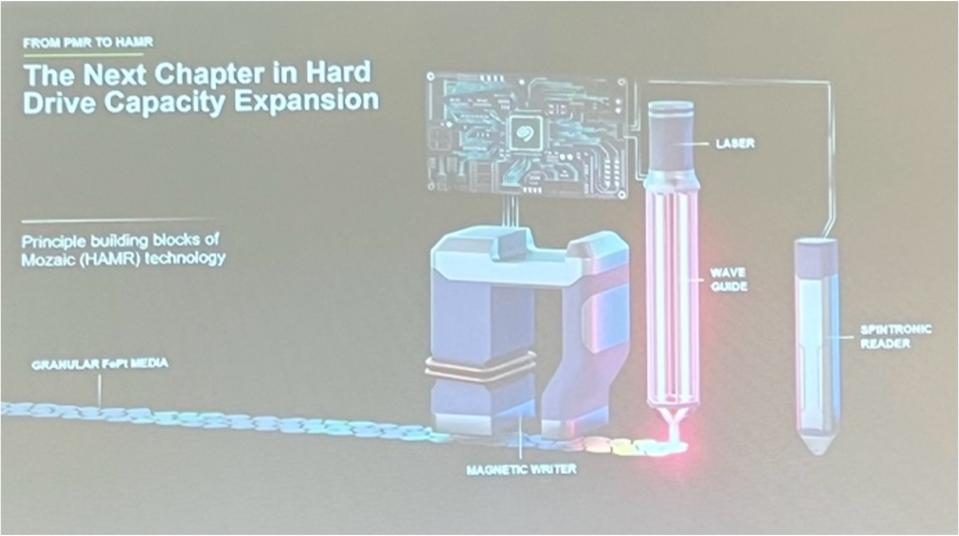This year marks the 45th year of the International Conference on Massive Storage Systems and Technology (MSST). It is the oldest continuous IEEE conference on digital storage technology. Topics at the event ranged from using automation for storage management code and setting up Retrieval-Augmented Generation, RAG, to the history of network file systems, NFS, and progress on PNFS, to object storage to developments in hard disk drives, HDDs, and LTO magnetic tape.
At the conference there were lots of talks on the second day about the history of NFS, as well as several talks about developments in parallel network file systems, PNFS. Many people involved in the creation and evolution of NFS 40 years ago were in attendance and on the second day there was a 40th anniversary part for NFS. There were also talks on object storage and various talks on digital storage for AI workflows.
Riyan Mendosa, from Seagate, gave a talk on the History of heat assisted magnetic recording, HAMR, and the Path to 10TB/disk and beyond. Seagate has been shipping HAMR HDDs in volume since 2024. Competitors Western Digital and Toshiba plan to ship HAMR HDDs in 2026. The picture below is a cartoon showing the layout of the HAMR head components and the media.
The picture below shows pictures of the current configuration of Seagate HAMR magnetic heads showing the laser structure sticking out above the slider. Seagate has been buying these lasers but they are moving to manufacturing their own, much more integrated lasers in their HAMR HDDs.
Seagate is using HAMR to leverage the growth in the storage capacity of their HDDs, particularly for nearline applications, but eventually in less populated HDDs. The image below shows laboratory demonstration and shipping product per disk capacities. Although the year is not shown they announced a 6.5TB/disk laboratory demonstration at the IEEE MMM Conference in 2024.
30TB+ HDDs with HAMR are shipping today with 40TB+ planned in 2026 and 50TB+ perhaps in 2027. They also project a 10TB/disk laboratory demonstration, perhaps by 2026-2027. They project moving from laboratory demonstration to product capacities in 5 years. This would project 100TB+ HDDs by the early 2030’s.
The image below shows projections for technology beyond 10TB/disk. This includes reaching 15TB/disk using including improved granular magnetic recording media or multiple layer, 3D, magnetic recording. Going beyond 15TB/disk will likely require patterned magnetic recording media. All of these technologies are also using perpendicular magnetic recording and HAMR.
An interesting aspect about this move to HAMR in hard disk drives is that this could drive HDD companies to become manufacturers of the vast majority of the world’s lasers. I did a search and found some suggestions that the total number of industrial and commercial lasers was somewhat less than 10 million units in 2024.
Coughlin Associates estimates that about 71M nearline HDDs were shipped in 2024 out of 124M total. The total number of nearline HDDs is projected to grow in the future driven by the need to store large amounts of data at low cost to support AI workflows and other big data applications.
Nearline HDDs tend to be high capacity and trend towards the highest number of disks per drive, which is 10 per drive for Seagate, although WDC have HDDs with up to 11 disks per drive. To get the highest per HDD capacity, every disk will have two heads, one for each side of the disk.
If all of the nearline HDDs in 2024 were each to have 10 disks each, the actual number is somewhat lower, each of these drives would have 20 heads. The total number of heads for the 70M nearline drives would then require 20 X 70M, or 1.4B heads. If all of these heads were HAMR heads they would need 1.4 billion lasers. This would be 140 times more lasers made than in the current estimated industrial and commercial laser market!
Seagate and the other manufacturers of heads for HDDs could achieve manufacturing scale for making lasers for HAMR heads that would dwarf other applications. This scale could make Seagate a dominate player in the commercial laser market and could make it competitive as a laser source for other applications. These could include optical recording and various communication applications, including photonics communication in new chip packages.
Matt Ninesling, from Spectra Logic talked about magnetic tape media trends. Spectra Logic manufacturing large magnetic tape library systems. The image below shows information about the latest generation LTO 10 tape format with 30TB per tape native capacity.
This allows building higher capacity tape libraries with the image below showing Spectra logic tape library offerings. These libraries are serial attached SCSI, SAS, products primarily.
The 2025 IEEE MSST celebrated 40 years of NPS and PFNS development. HDD move to HAMR could make them the largest manufacturer of commercial lasers as well as enabling high-capacity HDDs.

